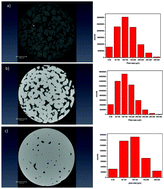Crystallization and sintering of borosilicate bioactive glasses for application in tissue engineering
Abstract
Typical silicate bioactive glasses are known to crystallize readily during the processing of porous scaffolds. While such crystallization does not fully suppress the bioactivity, the presence of significantly large amounts of crystals leads to a decrease in the rate of reaction of the glass and an uncontrolled release of ions. Furthermore, due to the non-congruent dissolution of silicate glasses, these materials have been shown to remain within the surgical site even 14 years post-operation. Therefore, bioactive materials that can dissolve more effectively and have higher conversion rates are required. Within this work, boron was introduced, in the FDA approved S53P4 glass, at the expense of SiO2. The crystallization and sintering-ability of the newly developed glasses were investigated by differential thermal analysis. All the glasses were found to crystallize primarily from the surface, and the crystal phase precipitation was dependent on the quantity of B2O3 incorporated. The rate of crystallization was found to be lower for the glasses when 25, 50 and 75% of SiO2 was replaced with B2O3. These glasses were further sintered into porous scaffolds using simple heat sintering. The impact of glass particle size and heat treatment temperature on the scaffold porosity and average pore size was investigated. Scaffolds with porosity ranging from 10 to 60% and compressive strength ranging from 1 to 35 MPa were produced. The scaffolds remained amorphous during processing and their ability to rapidly precipitate hydroxycarbonate apatite was maintained. This is of particular interest in the field of tissue engineering as scaffold degradation and reaction is generally faster and offers higher controllability as opposed to the current partially/fully crystallized scaffolds obtained from the FDA approved bioactive glasses.

- This article is part of the themed collection: Journal of Materials Chemistry B Emerging Investigators


 Please wait while we load your content...
Please wait while we load your content...